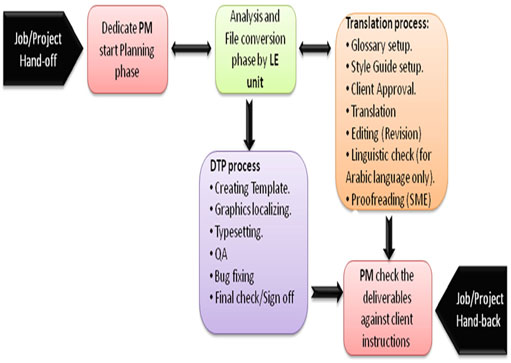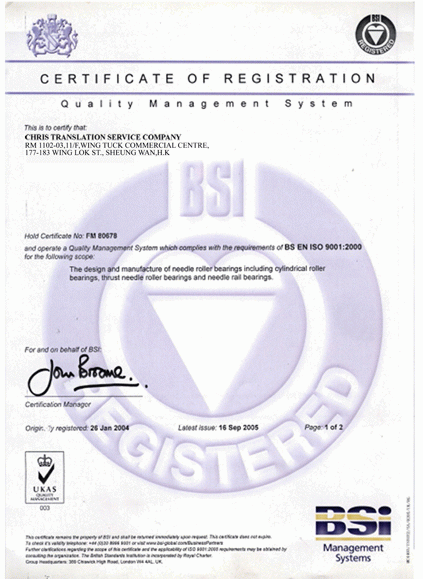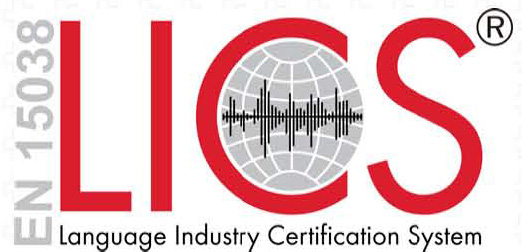 |
 |
|
 |
| n TOP > Quality > Workflow
Management for Quick Delivery of Large Volume Translation |
Translation Quality
(Workflow Management for Quick Delivery of Large Volume Translation) of Chris Translation
|
| System to translate a large volume of text
in a short delivery time |

As the pace of business has accelerated and product lifecycles have been
shortened, translation companies are increasingly required to translate a large amount of
information on a tight schedule. Because translation originally requires a good deal of
manual work, there are limitations to translating a large volume of information in a short
delivery time.
We defined the entire in-house translation process from receiving an order from a customer
to delivery as a supply chain system, and started reviewing the system to find how to
translate a large volume of information in a short delivery time.
To translate a large volume of information in a short delivery time, Chris Translation is
working to streamline translation processes through system development, project management
improvement, and accumulation of expertise as follows: |
 |
1. Reduce or eliminate the time required to secure or select translators |
To satisfy needs for quick delivery of large volume translation without
compromising the quality, we must be able to secure a necessary and sufficient number of
good translators when needed. Conventionally, it took coordinators or project managers
considerable time to enlist translators, select and approach appropriate translators, and
arrange assignments.
Chris Translation established the Resource Management Division, which
responds quickly to needs on site and meets a request for securing translators in a timely
fashion.
In addition, the Automatic Assignment Process, which is based on linkage
between the Chris Translation Information System and the Internet and designed to promote
smooth communications with registered translators, is under development to reduce the time
required to secure translators. |
 |
2. Convert original text only available in hardcopy into electronic files
at high speed for speeding up translation processes |
Electronic files of original text help reduce lead times because they can
be pre-processed, they can be transferred over networks, and translation support tools can
be used with them.
Even if original text is only available in hardcopy, we can now create correct electronic
files of the original text in minutes by incorporating text scanning, optical
character recognition (OCR), and proofreading semi-automatically into business processes,
provided that we obtain consent from the customer. |
 |
3. Reduce the time required to send or receive files |
The time required to send or receive files to or from customers or time
required to control file transfers or versions in in-house processes increases with
increases in the number of files to be handled. The risk of mistakes in file transfers
also increases with increases in the number of files.
Chris Translation is developing a semi-automatic file control process to
control file sending and receiving in order to minimize the time required to send or
receive files. |
 |
4. Reduce the time required to check terms or reference materials or to
read and follow style guides or specifications |
We employ pre-processing of terms to extract certain
terms and embed translations for them. This process reduces time required to use the same,
consistent technical terms, proper nouns, and terms of frequent occurrence and helps
translators work efficiently.
We also developed a style check tool to check translations for breaches of style guides or
specification rules in seconds. This tool is intended to reduce the time required to check
or proofread translations in post-processing. |
 |
5. Recycle repeated sentences at high speed |
| We make effective use of translation memory tools to
find the same sentences or fuzzy matches in a single or two or more related document files
in order to recycle translations. This dramatically reduces the time required for
translation of repetitive documents. |
 |
6. Reduce the period of time required by critical chain-based project
management |
| We use critical chain management methods such as analyses of
bottlenecks and buffer management to reduce the time required for a large
project. |
 |
7. Reduce the time required in DTP and engineering processes |
| We invest in high spec machines for compilation and
other building work regardless of the expense in order to reduce the time required for
engineering. |
|
 |
 |





